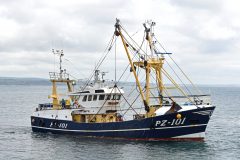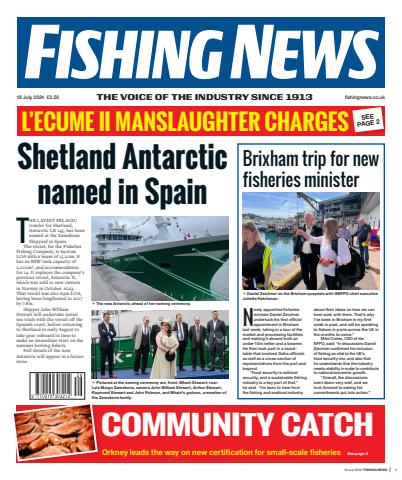Major study spells out dangers to sector
A major new report on the shellfish trade, aimed at the UK government, warns of severe impacts on the UK shellfish sector if there is no Brexit deal
It emphasises the importance of the EU market for almost all UK shellfish, and the tariff costs that the sector would be exposed to without a trade deal. It warns of the problems border delays would create, and points to the difficulties of finding alternative markets.
The main representative UK shellfish sector bodies (Shellfish Association, NFFO, SFF), with financial support from the Worshipful Company of Fishmongers and shellfish businesses, commissioned Cumulus Consultants to produce the report.
The study assumes a no-deal scenario with the EU in order to focus both government and the sector’s attention to where the pitfalls lie and how best to prepare for them.
A spokesman for the three organisations said: “Businesses throughout the shellfish supply chain in the UK and in the EU are reliant on smooth, unimpeded trade. We are dependent on the European market, but likewise there is heavy dependence on our products on the continent. We have undertaken this study to identify the issues to ensure that, as far as possible, no part of our industry will be disadvantaged. The study makes clear that both in terms of the tariff regime but also non-tariff barriers, there is a great deal at stake.
“The primary audience for our report is government. It is there to help guide the UK negotiators to a deal with the EU which protects businesses throughout the shellfish supply chain, in the UK and EU.”
The report says:
- Europe provides the single high-value, high-volume market for most of the species produced or harvested in the UK. These high-value European markets are the result of traditions of shellfish consumption. The possibility of replacing EU markets with alternative high-value markets is challenged not only by the difficulty of reproducing such traditions through marketing, but also by the global production and trade of most shellfish types. Similarly, UK consumption of shellfish is unlikely to be affected by the UK’s departure from the EU. The UK will not replace the French, Spanish, Italian, Portuguese or Dutch markets for higher-value live, fresh or chilled shellfish. The opportunities to develop alternative markets are relatively small-scale and might equally be exploited by EU member states or by other players in the global shellfish trade. The advantages of preferential trade deals will not emerge quickly and cannot be seen as a substitute for the current European markets.
- Brexit has potentially significant impacts for the UK shellfish trade.
While the nature of the future trading relationship between the UK and the EU remains unknown following the UK’s departure from the EU, the potential changes that might occur are outlined as:
- EU tariffs could cost the shellfish sector up to £41m annually.
In the event of no agreement being reached on a UK-EU free trade agreement (FTA), UK shellfish exports to the EU would be subject to the EU’s ‘most favoured nation’ (MFN) tariffs. The total cost of these tariffs would be in the region of £41m per year, and in the worst case would have to be fully absorbed by the UK shellfish sector, equivalent to an average of 8.7% taken from the value of exports to the EU.
- Whether price increases can be passed on to EU consumers will depend on the extent to which products are viewed as scarce and of non-substitutable luxury value, as well as on broader economic parameters (eg, ability to pay a higher price, sterling-euro exchange rate and strength of the EU economy post-Brexit). The extent to which the UK industry can absorb a direct reduction in profit is similarly contingent on broader economic parameters (eg, labour and transport costs and again the sterling-euro exchange rate).
UK dominant supplier
The UK is a dominant supplier of some species, including, for example, the European lobster. However, for no species is the UK the sole supplier and for no species is there not the possibility of product substitution. As such, it remains likely that the major part of the tariff impact will be absorbed by UK producers. If the implementation of tariffs were to lead to sudden and marked price increases in destination markets then this in itself could trigger changes in consumer behaviour and demand for UK shellfish.
For some species, including mussels, oysters, clams, cockles and razor clams, the UK does not have a dominant position in either production or trade. For these molluscs, any impact on trade (ie tariffs) will necessarily be absorbed by UK suppliers.
The UK is not the sole supplier of most shellfish species traded into the EU and there is strong competition for live, fresh or chilled and for frozen and processed products from other countries. In some cases, these third-countries benefit from zero-percent tariffs on exports into the EU.
- The UK shellfish sector could be exposed to third country tariffs in the region of £6m per year when outside the EU.
UK shellfish exports to the rest of the world would also be impacted by changes arising from Brexit. In particular, the UK would no longer be party to the EU-South Korea FTA; if tariffs were applied to the export of whelks from the UK to South Korea, this would cost the UK industry a further £5.8m annually.
- Non-tariff barriers could result in additional time and costs, hitting live and fresh shellfish exports hardest.
There is range of potential non-tariff barriers which, among other impacts, could result in delay and/or add cost to shellfish exports. Delay is anticipated to occur post-Brexit as a result of additional paperwork and physical checks at borders; it is anticipated that these checks and delays would be greatest if no agreement is reached between the UK and the EU.
Live shellfish exports will have the least flexibility to absorb delays, followed by fresh shellfish and then frozen products. The impact can vary by type of shellfish and transport used.
Small delays can result in missed connections, leading to longer delays, as well as let-down customers. Longer delays can result in shorter shelf life, loss of freshness, reduced quality and mortality.
The knock-on impacts of delay can include lower prices, total loss of sale and additional costs, with repeated delays resulting in damaged reputation and loss of customers and markets over time. Even a small increase in total travelling time could make some long-distance trade untenable (eg, live langoustine from West of Scotland).
The report has been presented to DEFRA and the Department for Exiting the EU (DEXEU) and meetings are scheduled with both departments to discuss the implications of the study findings.
Shellfish sector facts
- The shellfish sector is the largest of the three fishing sectors in the UK, representing 36% of the value of fish landed into the UK and abroad by UK vessels, and 46% of the value of fish landed into the UK in 2016. The total value at first landing was estimated at £339m, with landings into the UK of £318m. These figures exclude value added through processing, packaging and marketing, and changes in values since 2016.
- The shellfish sector is dispersed around the coastline of the whole of the UK and is important economically and culturally to a large number of ports and coastal communities. At least 1933 vessels (41% of all active fishing vessels) fish for shellfish in the UK, supporting at least 4,313 full-time equivalent (FTE) jobs (54% of all FTEs involved in fishing). Shellfish are processed at 79 shellfish-only processing facilities and 55 mixed species processors, with shellfish-only sites accounting for an estimated 3,950 FTE jobs (29% of all FTE jobs in sea fish processing).
- Most UK shellfish is exported to the EU – live, fresh or chilled shellfish provides the highest value. Fresh, frozen and smoked shellfish exports in 2017 were valued at over £500m, with exports to the EU in the region of £432m (85%) and exports to the rest of the world in the region of £77m (15%). The UK also exported £39m of prepared shellfish to the EU. The UK market for UK shellfish, although highly valued by the fishing industry, is believed to be small in relation to the EU market for these same fish. The principal destinations of UK shellfish in the EU are France, Spain and Italy. Key rest of the world markets include China and South Korea.
- With very few exceptions, it is the trade in live, fresh or chilled shellfish with EU Member States which provided the highest value. For the most part, it would appear that UK shellfish exports to the EU are consumed within EU member states, rather than being further traded to other non-EU countries.
- The relevance of particular countries for UK shellfish exports varies by species; eg, brown crab (France, Spain and Portugal), velvet crab (Spain), lobster (France and Spain), Nephrops (France and Spain), cuttlefish (Spain, Italy and the Netherlands), scallops (France and Italy), clams (France, Spain, the Netherlands), and mussels (the Netherlands). France is the principal export market for crustaceans, followed by Spain, Portugal and Italy, while the Netherlands and, to a lesser extent, Spain and France are of particular relevance for molluscs, and Spain, Italy and the Netherlands are of relevance for cephalopods.






